Please Take Note: This is a review of the final game, but it might change slightly based on the success of the Kickstarter campaign. The game is being reviewed on the components and the rules provided with the understanding that “what you see is not what you might get” when the game is published. If you like what you read and want to learn more, we encourage you to visit the game publisher’s website or visit the Kickstarter campaign. Now that we have all that disclaimer junk out of the way, on with the review.
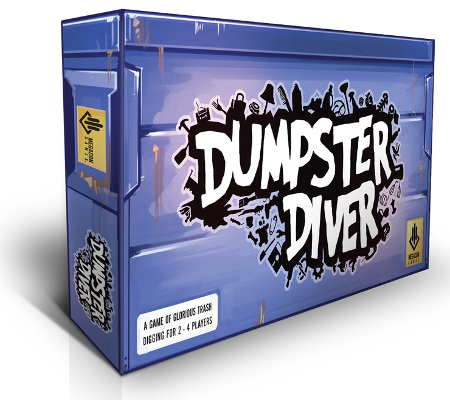
The Basics:
- For ages 7 and up (publisher suggests 8+)
- For 2 to 4 players
- Approximately 30 minutes to complete
Geek Skills:
- Counting & Math
- Logical & Critical Decision Making
- Pattern/Color Matching
- Strategy & Tactics
- Risk vs. Reward
- Hand/Resource Management
Learning Curve:
- Child – Easy
- Adult – Easy
Theme & Narrative:
- Turn dirty old rags to gleaming riches
Endorsements:
- Gamer Geek mixed!
- Parent Geek approved!
- Child Geek approved!
Overview
There will always be others who see a glint of gold in a tarnished glass, a sparkle of diamonds in a cracked mirror, and rich history in an old cracked bookcase. These collectors look past the obvious and see the true value of objects that others never glimpse. You are such an individual and you have recently found the “Mother Load” of junk that can be turned into hard cash. The only trick is getting to it first.
Dumpster Diver, designed by Brian Shotton and to be published by MegaCon Games, will reportedly be comprised of 1 Victory Point board, 1 Starting Player token, 4 Player markers, 74 cards, and 40 Money tokens (in the values of 1, 3, 5, and 10). As this is a prepublished version of the game, I cannot comment on the game component quality.
One Man’s Trash…
To set up the game, first place the Victory Point board off to one side of the game playing area. I find it best to assign the job of tracking scores to one player to make the game go smoother.
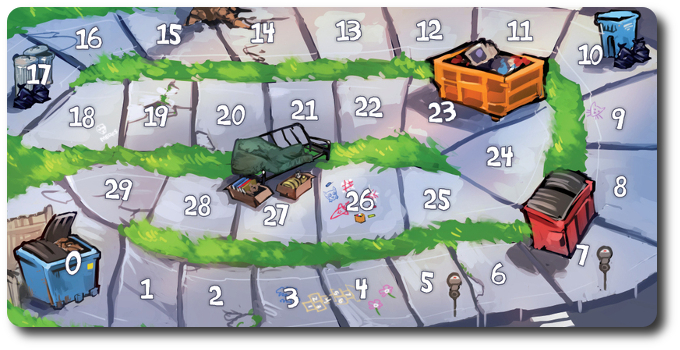
Second, give each player 5 Money tokens (for a total of value of 5) and place the rest off to one side of the game playing area. Again, I find it best to assign a player to be in charge of these game bits. Call them “the Banker”.
Third, give each player 1 Player marker and the matching Protection card. Place any Protection cards and Player markers not used back in the game box. Place the in-play Player markers on the “0” spot found on the Victory Point board.
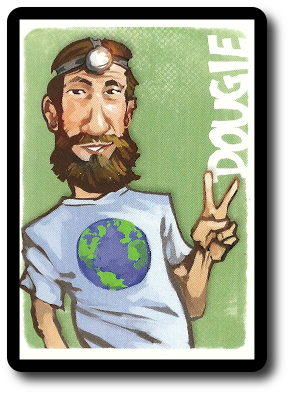
Fourth, shuffle the “10 VP” cards and draw 1. Place the drawn “10 VP” card next to the Victory Point board, face-up. Place the rest of the “10 VP” cards back in the game box.
Fifth, shuffle the remaining cards (referred to as “Treasure”) to create the Treasure draw deck. Place the Treasure draw deck in the middle of the playing area.
Sixth, draw the top 4 cards from the Treasure draw deck and place them face-down next to it to create the Trash pile.
Determine who will go first, give them the Starting Player marker, and begin.
Is Another Man’s Treasure
Dumpster Diver is played in rounds and turns. Each round is divided into phases where players take turns in different turn order sequence. A game round is summarized here.
Note: Except for the first round, where the Starting Player is determined at random, the Starting Player marker is given to the player with the fewest Victory Points. Ties are broken on how much money the players have.
Phase 1: Draw
Beginning with the Starting Player, each player draws 1 card from the Treasure deck, adding it to their hand. This continues in turn order sequence until each player has drawn a total of 4 cards each.
Phase 2: Protect
At the same time, each player selects 1 of the 4 cards they drew to protect. This card is placed face-down underneath their Protection card. Protected cards will return to the player’s hand later in the round, but for now, are off-limits to all opponents.
Phase 3: Sell
At the same time, each player selects 1 of the 3 remaining cards in their hand to sell. This card is placed face-up in front of the player. Then the player determines the price of their card and indicates what it can be purchased for by playing an equal amount of Money tokens on the card to be sold. The total money value indicates the selling price.
Phase 4: Buy
Beginning with the Starting Player, each player decides upon a Treasure card to buy. After the Starting Player, the player with the fewest Victory Points goes next, and so on until the player with the most Victory Points who has not gone is given a turn to buy.
The payment is given to the player who owns the card and the purchased card is placed underneath the player’s Protection card. At no time is a player required to purchase an opponent’s card. They can elect to pass if they so choose.
If a card is purchased, the money on it (indicating the price) and the money given are taken by the player. However, if no one buys the Treasure card, the player MUST purchase it. The Money tokens go to the Bank and the Treasure card is placed underneath the player’s Protection card.
Phase 5: Dive
The 2 remaining cards in the player’s hand represent the various Trash Dumpsters found around town. Beginning with the Starting Player and continuing clockwise, each player draws 1 Treasure card from another opponent’s hand. The drawn card is placed underneath the player’s Protection card.
When the last player draws their first card, they draw again. Then the turn order sequence goes in reverse, counter-clockwise, until the first player to draw a card is now the last player to draw a card.
A player can draw a card when their Trash Dumpster is empty (they hold no cards). If none of the other opponents are holding cards, the player must select 1 of their cards.
During the second and subsequent rounds, players can draw 1 card from the Trash pile, adding it to their Protection card.
Phase 6: Play
Beginning with the player with the most Victory Points, all players now take their cards that were protected and attempt to play as many Sets and Collections as possible to the table. Score Victory Points as they are earned.
- Set: Any number of matching cards
- Collection: Any number of non-matching cards
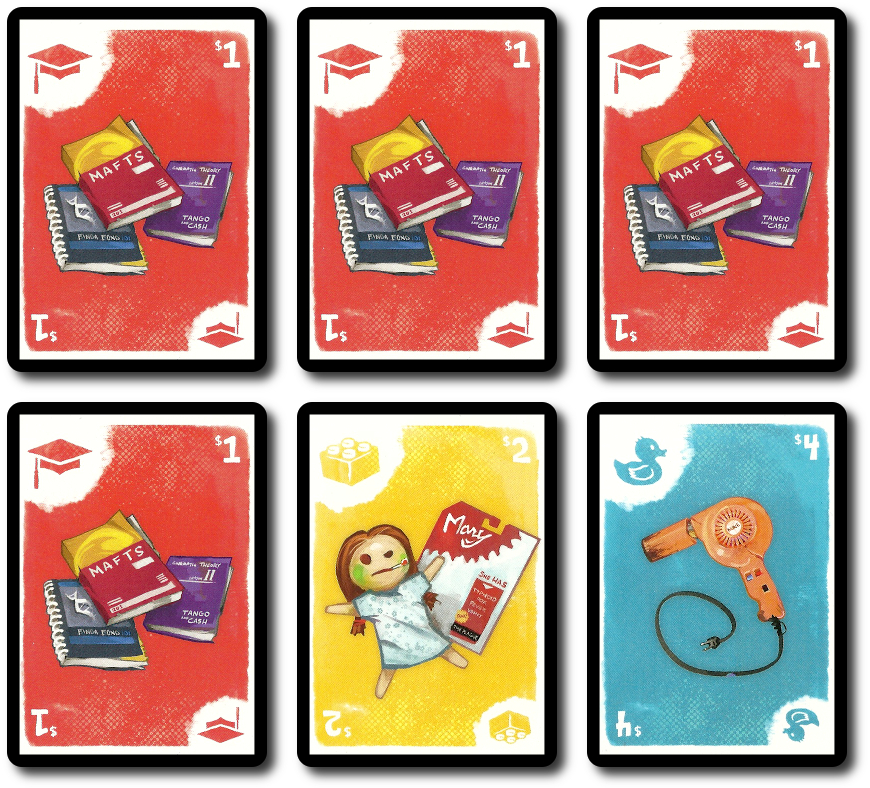
Each new Set and Collection must be made up of at least 3 cards each.
Players can play off of an opponent’s Set and Collection that was previously played, but before they can do so, they must play their own complete Set or Collection.
Various card plays and card types determine different Victory Point values. Boosters can be played to increase points, as well as money.
Players are not required to play any cards if they do not want to.
Phase 7: Money
Any cards left in the player’s hand after the previous phase award the player Money tokens. The total amount of money given is based on the card’s value. Then the cards are placed face-down in the Trash pile.
Phase 8: Refresh
The Treasure deck is reshuffled and placed in the middle of the table again. Then the Trash pile is shuffled loosely and kept more as a “jumble” than a real draw deck.
A new round now begins.
End of the Trash Trail
The final round is triggered when a player draws the last card from the Treasure draw deck. The round is completed as normal. At the end of the round, final points are scored.
- Victory Points are earned for any Money tokens the player may have (1 VP for every $3)
- Bonus Victory Points are earned for Sets and Collections (a Set of 8 or more cards earns 10 VP, a completed Collection earns 5 VP)
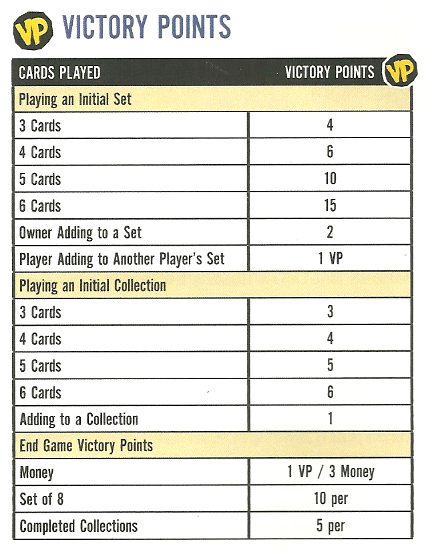
The winner of the game is the player with the most Victory Points.
To learn more about Dumpster Diver, visit the game publisher’s website or visit the Kickstarter campaign.
Final Word
 The Child Geeks liked just about every aspect of the game, but failed to grasp the overall level of control they had during each phase. Which is not to say they did not play smart. Rather, they played with an obvious sense of indifference between one phase to the next. As one Child Geek put it, “Each turn is an opportunity to get more cards to play to the table. I just look for the right colors.” This would suggest that the Child Geeks were just looking for the “next action” instead of viewing the game as a series of tactical moves. But that is not the case. According to one Child Geek, “As the game goes on, you have more and more chances to build on what you did the last turn. If you build smart, collect smart, and play smart, you’ll always win.” So there were a few Child Geeks who saw the game in a bigger picture than their playing style would suggest. Regardless, all the Child Geeks very much enjoyed the game and awarded Dumpster Diver their full approval.
The Child Geeks liked just about every aspect of the game, but failed to grasp the overall level of control they had during each phase. Which is not to say they did not play smart. Rather, they played with an obvious sense of indifference between one phase to the next. As one Child Geek put it, “Each turn is an opportunity to get more cards to play to the table. I just look for the right colors.” This would suggest that the Child Geeks were just looking for the “next action” instead of viewing the game as a series of tactical moves. But that is not the case. According to one Child Geek, “As the game goes on, you have more and more chances to build on what you did the last turn. If you build smart, collect smart, and play smart, you’ll always win.” So there were a few Child Geeks who saw the game in a bigger picture than their playing style would suggest. Regardless, all the Child Geeks very much enjoyed the game and awarded Dumpster Diver their full approval.
 The Parent Geeks did see the game for what it was and also immediately recognized it as a Rummy derivative, but not in a negative way. According to one Parent Geek, “Knowing it is like Rummy helped me learn how to play it and I’m pretty sure allowed non-gamers to play it, too.” The most interesting aspect of the game to the Parent Geeks was the Selling phase. They liked that a player could sell a card for a lot if they thought it would benefit another player without really hurting their chances of winning, either. As one Parent Geek put it, “If you know players want a certain card, you can ask a high price. They’ll usually pay because it’s all just points in the end. But more money means more options.” The only aspect of the game the Parent Geeks didn’t like was the sloppy Trash pile. They kept wanting to “clean it up”, despite me telling them – repeatedly – “Stop touching the Trash pile; it’s supposed to be a mess”. For the non-gamers, this was almost sacrilegious! But they all got through it and voted to fully approve Dumpster Diver.
The Parent Geeks did see the game for what it was and also immediately recognized it as a Rummy derivative, but not in a negative way. According to one Parent Geek, “Knowing it is like Rummy helped me learn how to play it and I’m pretty sure allowed non-gamers to play it, too.” The most interesting aspect of the game to the Parent Geeks was the Selling phase. They liked that a player could sell a card for a lot if they thought it would benefit another player without really hurting their chances of winning, either. As one Parent Geek put it, “If you know players want a certain card, you can ask a high price. They’ll usually pay because it’s all just points in the end. But more money means more options.” The only aspect of the game the Parent Geeks didn’t like was the sloppy Trash pile. They kept wanting to “clean it up”, despite me telling them – repeatedly – “Stop touching the Trash pile; it’s supposed to be a mess”. For the non-gamers, this was almost sacrilegious! But they all got through it and voted to fully approve Dumpster Diver.
 The Gamer Geeks also recognized Dumpster Diver as a Rummy’ish game, but didn’t much care if it was. According to one Gamer Geek, “Rummy is a great game and I have yet to play a game like Rummy I haven’t enjoyed.” Enjoy the game they did, but not the majority. One Gamer Geek said, “The game is OK, but feels a bit phoned in, if you know what I mean. It works and works well, but doesn’t feel fresh or knew. I guess I’ve played too many games.” But for others, Dumpster Diver was a lot of fun. One enthusiastic Gamer Geek said, “A great game, full of thoughtful plays, critical thinking, and depth. I could play this would anyone and have a great time.” Unfortunately for the game, not everyone felt the same way. The end result was that Dumpster Diver was given a mixed review from the Gamer Geeks.
The Gamer Geeks also recognized Dumpster Diver as a Rummy’ish game, but didn’t much care if it was. According to one Gamer Geek, “Rummy is a great game and I have yet to play a game like Rummy I haven’t enjoyed.” Enjoy the game they did, but not the majority. One Gamer Geek said, “The game is OK, but feels a bit phoned in, if you know what I mean. It works and works well, but doesn’t feel fresh or knew. I guess I’ve played too many games.” But for others, Dumpster Diver was a lot of fun. One enthusiastic Gamer Geek said, “A great game, full of thoughtful plays, critical thinking, and depth. I could play this would anyone and have a great time.” Unfortunately for the game, not everyone felt the same way. The end result was that Dumpster Diver was given a mixed review from the Gamer Geeks.
 I’ve played many Rummy-like games and Dumpster Diver is no different than the masses. The goal is the same, but the method in which the goal is obtained is always slightly different. In this case, the players are “banking” cards for later use, with a diminishing level of control over what cards are kept. I really liked this, as it allowed the players to form a strategy and subtly shift their tactics as the game progressed. Expecting one card but got another? No problem! There will be opportunities to build around mistakes and take advantage of happy accidents.
I’ve played many Rummy-like games and Dumpster Diver is no different than the masses. The goal is the same, but the method in which the goal is obtained is always slightly different. In this case, the players are “banking” cards for later use, with a diminishing level of control over what cards are kept. I really liked this, as it allowed the players to form a strategy and subtly shift their tactics as the game progressed. Expecting one card but got another? No problem! There will be opportunities to build around mistakes and take advantage of happy accidents.
The game is smooth and plays quickly. None of our groups ever felt rushed or frustrated due to the game’s length or quickness of rounds. In fact, I think the speed in which the game is played works towards the game’s theme. Rushing around, grabbing trash that may or may not be worth something is frantic business, but not so much that players don’t have time to consider what they are doing. It’s all about taking advantage of a possible opportunities that may or may not really be there. It can be confusing at times, but as the game progresses, there is no such thing as a “bad card”.
But there is a point of diminishing returns. You cannot play this game in the blind and you most certainly cannot sleep your way through it. It takes a lot of thought at times, surprisingly so, and other times the obvious choice is so obvious that you cannot help yourself from second guessing. All the while, the points the players have earned are clearly visible, the amount that needs to be earned to keep up or stay ahead is right there in front of you. You know how hard to push and when to throttle back. The game gives a lot of information to the player and a lot of opportunity. The end result is a very satisfying game. Do give it a try when time permits.
This is a paid for review of the game’s final prototype. Although our time and focus was financially compensated, our words are our own. We’d need at least 10 million dollars before we started saying what other people wanted. Such is the statuesque and legendary integrity of Father Geek which cannot be bought except by those who own their own private islands and small countries.



